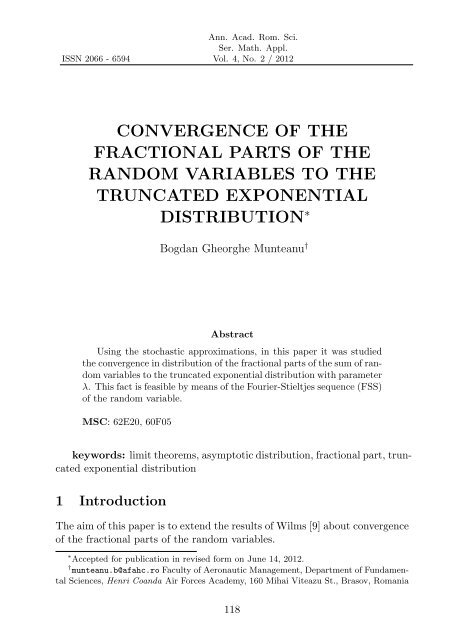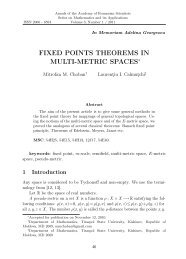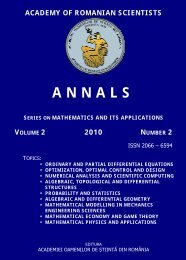convergence of the fractional parts of the random variables to the ...
convergence of the fractional parts of the random variables to the ...
convergence of the fractional parts of the random variables to the ...
Create successful ePaper yourself
Turn your PDF publications into a flip-book with our unique Google optimized e-Paper software.
Ann. Acad. Rom. Sci.<br />
Ser. Math. Appl.<br />
ISSN 2066 - 6594 Vol. 4, No. 2 / 2012<br />
CONVERGENCE OF THE<br />
FRACTIONAL PARTS OF THE<br />
RANDOM VARIABLES TO THE<br />
TRUNCATED EXPONENTIAL<br />
DISTRIBUTION ∗<br />
Bogdan Gheorghe Munteanu †<br />
Abstract<br />
Using <strong>the</strong> s<strong>to</strong>chastic approximations, in this paper it was studied<br />
<strong>the</strong> <strong>convergence</strong> in distribution <strong>of</strong> <strong>the</strong> <strong>fractional</strong> <strong>parts</strong> <strong>of</strong> <strong>the</strong> sum <strong>of</strong> <strong>random</strong><br />
<strong>variables</strong> <strong>to</strong> <strong>the</strong> truncated exponential distribution with parameter<br />
λ. This fact is feasible by means <strong>of</strong> <strong>the</strong> Fourier-Stieltjes sequence (FSS)<br />
<strong>of</strong> <strong>the</strong> <strong>random</strong> variable.<br />
MSC: 62E20, 60F05<br />
keywords: limit <strong>the</strong>orems, asymp<strong>to</strong>tic distribution, <strong>fractional</strong> part, truncated<br />
exponential distribution<br />
1 Introduction<br />
The aim <strong>of</strong> this paper is <strong>to</strong> extend <strong>the</strong> results <strong>of</strong> Wilms [9] about <strong>convergence</strong><br />
<strong>of</strong> <strong>the</strong> <strong>fractional</strong> <strong>parts</strong> <strong>of</strong> <strong>the</strong> <strong>random</strong> <strong>variables</strong>.<br />
∗ Accepted for publication in revised form on June 14, 2012.<br />
† munteanu.b@afahc.ro Faculty <strong>of</strong> Aeronautic Management, Department <strong>of</strong> Fundamental<br />
Sciences, Henri Coanda Air Forces Academy, 160 Mihai Viteazu St., Brasov, Romania<br />
118
Convergence <strong>of</strong> <strong>the</strong> <strong>fractional</strong> <strong>parts</strong> <strong>of</strong> <strong>the</strong> <strong>random</strong> <strong>variables</strong> 119<br />
This <strong>the</strong>ory was analysed by Wilms in [9], where <strong>the</strong> study <strong>of</strong> <strong>convergence</strong><br />
<strong>of</strong> <strong>the</strong> <strong>fractional</strong> <strong>parts</strong> <strong>of</strong> <strong>the</strong> sum <strong>of</strong> <strong>random</strong> <strong>variables</strong> it was directed <strong>to</strong>wards<br />
<strong>the</strong> uniform distribution on <strong>the</strong> interval [0, 1]. Moreover, he identifed <strong>the</strong><br />
necessary and sufficient conditions for <strong>the</strong> <strong>convergence</strong> <strong>of</strong> <strong>the</strong> product <strong>of</strong> <strong>the</strong><br />
<strong>random</strong> <strong>variables</strong>, not necessary independent and identically distributed,<br />
<strong>to</strong>wards <strong>the</strong> same uniform distribution on <strong>the</strong> interval [0, 1]. The Fourier-<br />
Stieltjes sequence, (see Definition 1), play an important role in <strong>the</strong> study <strong>of</strong><br />
<strong>fractional</strong> <strong>parts</strong> <strong>of</strong> <strong>random</strong> <strong>variables</strong>. Also, Wilms obtain conditions under<br />
which <strong>fractional</strong> <strong>parts</strong> <strong>of</strong> products <strong>of</strong> independent and identically distributed<br />
<strong>random</strong> <strong>variables</strong> are uniform distribution on <strong>the</strong> interval [0, 1]. After a<br />
survey <strong>of</strong> some results by Schatte in [6], Wilms extend <strong>the</strong> results <strong>of</strong> Schatte<br />
on sums <strong>of</strong> independent and identically distributed lattice <strong>random</strong> <strong>variables</strong>.<br />
Fur<strong>the</strong>rmore, Schatte in [6], gives rates for <strong>the</strong> <strong>convergence</strong> <strong>of</strong> distribution<br />
function <strong>of</strong> <strong>the</strong> <strong>fractional</strong> <strong>parts</strong> <strong>of</strong> <strong>the</strong> sum <strong>of</strong> <strong>random</strong> <strong>variables</strong> <strong>to</strong> distribution<br />
function <strong>of</strong> <strong>random</strong> <strong>variables</strong> with continouous uniform distribution on <strong>the</strong><br />
interval [0, 1].<br />
The novelty <strong>of</strong> this paper consist in <strong>the</strong> identification <strong>of</strong> <strong>the</strong> conditions<br />
(Theorems 4, 5, 6) when <strong>the</strong> distribution <strong>of</strong> <strong>the</strong> <strong>fractional</strong> <strong>parts</strong> <strong>of</strong> <strong>the</strong> sum<br />
<strong>of</strong> <strong>random</strong> <strong>variables</strong> converge <strong>to</strong> <strong>the</strong> truncated exponential distribution.<br />
2 Notations, definitions and auxiliary results<br />
Let (Ω , F , P) be <strong>the</strong> probability space and a <strong>random</strong> variable X, X : Ω → R<br />
measurable function. The distribution <strong>of</strong> <strong>random</strong> variable X is <strong>the</strong> measure<br />
<strong>of</strong> probability P X defined on B(R) Borel and P X (B) = P (X ∈ B). The<br />
distribution function <strong>of</strong> <strong>the</strong> <strong>random</strong> variable X is F X (x) = P(X < x), x ∈ R,<br />
x∫<br />
or F X (x) = f X (y)dy where f X represents <strong>the</strong> density <strong>of</strong> probability <strong>of</strong><br />
−∞<br />
<strong>the</strong> <strong>random</strong> variable X.<br />
Throughout <strong>the</strong> paper, for A ⊂ R, F(A) = {F X | P (X ∈ A) = 1}.<br />
For <strong>the</strong> <strong>random</strong> variable X, <strong>the</strong> <strong>fractional</strong> part <strong>of</strong> X is defined as follows:<br />
{X} = X − [X], where [X] represents <strong>the</strong> integer part <strong>of</strong> X.<br />
The distribution function <strong>of</strong> <strong>the</strong> <strong>random</strong> variable {X} for any x ∈ [0, 1]<br />
is<br />
F {X} (x) =<br />
∞∑<br />
m=−∞<br />
P(m ≤ X < m + x) =<br />
∞∑<br />
m=−∞<br />
(F X (m + x) − F X (m)) .
120 Bogdan Gheorghe Munteanu<br />
where F X is <strong>the</strong> distribution function <strong>of</strong> <strong>random</strong> variable X.<br />
The <strong>random</strong> variable X has truncated exponential distribution <strong>of</strong> parameter<br />
λ (denoted by X ∼ Exp ∗ (λ)), if its distribution function F X ∈ F([0, 1))<br />
and<br />
⎧<br />
⎨<br />
F X (x) =<br />
⎩<br />
0 , x < 0<br />
1−e −λx<br />
1−e −λ , x ∈ [0, 1]<br />
1 , x > 1<br />
Moreover, if <strong>random</strong> variable X has <strong>the</strong> density f X , <strong>the</strong>n:<br />
F {X} (x) =<br />
∞∑<br />
j=−∞<br />
that is h {X} (x) =<br />
∫<br />
j+x<br />
j<br />
f X (y)dy =<br />
∞ ∑<br />
j=−∞<br />
∞∑<br />
∫ x<br />
j=−∞<br />
0<br />
f X (j + t)dt =<br />
.<br />
∫ x<br />
0<br />
∞∑<br />
j=−∞<br />
f X (j + t)dt ,<br />
f X (j + x), x ∈ [0, 1] is <strong>the</strong> density <strong>of</strong> probability <strong>of</strong><br />
<strong>the</strong> <strong>random</strong> variable {X}. For example, if X ∼ Exp ∗ (λ), <strong>the</strong>n<br />
(<br />
F {X} (x) = 1 − e −λx) (<br />
/ 1 − e −λ) , x ∈ [0, 1].<br />
So, <strong>the</strong> characteristic function <strong>of</strong> <strong>the</strong> <strong>random</strong> variable X, ϕ X : R → C is<br />
defined by:<br />
∫+∞<br />
ϕ X (t) := Ee itX = e itx dF X (x) , (t ∈ R) .<br />
−∞<br />
Definition 1. The Fourier-Stieltjes sequence (FSS) <strong>of</strong> <strong>the</strong> <strong>random</strong> variable<br />
X is <strong>the</strong> function c X : Z → C defined by<br />
c X (k) := ϕ X (2πk) , k ∈ Z .<br />
Proposition 1. ([9]) For any <strong>random</strong> variable X <strong>the</strong> following relation occurs:<br />
c X (k) = c {X} (k) , ∀ k ∈ Z .<br />
The properties that characterizes <strong>the</strong> Fourier-Stieltjes sequence, it was<br />
presented a books [1], [3] and [5].<br />
Theorem 1. (<strong>of</strong> continuity, [5]) Let (F n ) ∈ F([0, 1)) be a sequence <strong>of</strong> <strong>the</strong><br />
<strong>random</strong> <strong>variables</strong>, and let (c n ) be FSS respectively.
Convergence <strong>of</strong> <strong>the</strong> <strong>fractional</strong> <strong>parts</strong> <strong>of</strong> <strong>the</strong> <strong>random</strong> <strong>variables</strong> 121<br />
(i). Let F ∈ F([0, 1)) be with c FSS respectively. If F n<br />
n→∞ →<br />
lim n→∞ c n (k) = c(k), pentru k ∈ Z.<br />
F , <strong>the</strong>n<br />
(ii). If lim n→∞ c n (k) = c(k) is for k ∈ Z, <strong>the</strong>n is F ∈ F([0, 1)) so that<br />
n→∞<br />
F n → F . Then <strong>the</strong> sequence c is FSS <strong>of</strong> F .<br />
We define <strong>the</strong> convolution F <strong>of</strong> distribution functions F 1 , F 2 ∈ F([0, 1))<br />
such that F ∈ F([0, 1)).<br />
Denote by F 1 ≡ F {X1 }, F 2 ≡ F {X2 } and F ≡ F {X1 +X 2 }.<br />
To this end, let F 1 ∗ F 2 denote <strong>the</strong> convolution in <strong>the</strong> cus<strong>to</strong>mary sense,<br />
[2], i.e.<br />
(F 1 ∗ F 2 ) (x) =<br />
∫ ∞<br />
−∞<br />
F 1 (x − y)dF 2 (y) =<br />
∫ ∞<br />
−∞<br />
with F 1 ∗ F 2 ∈ F([0, 2)) if F 1 , F 2 ∈ F([0, 1)) and x ∈ [0, 1].<br />
Definition 2. Let F, F 1 , F 2 ∈ F([0, 1)). The function<br />
(F 1 ⊗ F 2 ) (x) =<br />
is said <strong>to</strong> be <strong>the</strong> truncated convolution.<br />
F 2 (x − y)dF 1 (y),<br />
(F 1 ∗ F 2 ) (x)<br />
, x ∈ [0, 1]<br />
(F 1 ∗ F 2 ) (1) − (F 1 ∗ F 2 ) (0)<br />
In particular, if F 1 , F 2 ∈ F([0, 1)) is <strong>the</strong> distribution functions <strong>of</strong> <strong>random</strong><br />
<strong>variables</strong> X 1 and X 2 independent and identically exponential distributed,<br />
<strong>the</strong>n <strong>the</strong> distribution function <strong>of</strong> <strong>the</strong> sum <strong>of</strong> <strong>random</strong> <strong>variables</strong> X 1 and X 2<br />
(F<br />
in <strong>fractional</strong> part is F (x) =<br />
1 ∗F 2 )(x)<br />
(F 1 ∗F 2 )(1)−(F 1 ∗F 2 )(0) = 1−(1+λx)e−λx , with F ∈<br />
1−(1+λ)e −λ<br />
F([0, 1)), ∀ x ∈ [0, 1].<br />
Theorem 2. (<strong>of</strong> convolution, [9]) Let F, F 1 , F 2 ∈ F([0, 1)) be with FSS<br />
c, c 1 , c 2 . Then<br />
c = c 1 c 2 ⇐⇒ F = F 1 ⊗ F 2 .<br />
Corollary 1. ([9]) Let X and Y be two independent <strong>random</strong> <strong>variables</strong> with<br />
F X , F Y ∈ F([0, 1)). Then<br />
c {X+Y } = c X c Y .
122 Bogdan Gheorghe Munteanu<br />
The next result characterizes FSS with <strong>the</strong> help <strong>of</strong> <strong>the</strong> repartition function<br />
F X .<br />
Proposition 2. ([9]) Let F X ∈ F([0, 1)) be. Then<br />
∫ 1<br />
c F (k) = 1 − 2πik<br />
0<br />
F X (x)e 2πikx dx , k ∈ Z .<br />
The next <strong>the</strong>orem characterizes <strong>the</strong> <strong>convergence</strong> in distribution (denoted<br />
by ” d → ”) by means <strong>of</strong> FSS.<br />
Theorem 3. ([9]) Let (X m ) be a sequence <strong>of</strong> independent <strong>random</strong> <strong>variables</strong><br />
and S n :=<br />
n ∑<br />
m=1<br />
Then {S n } d → S if and only if<br />
X m , n ∈ N. Let S be <strong>the</strong> <strong>random</strong> variable with F S ∈ F([0, 1)).<br />
n∏<br />
m=1<br />
There are a couple <strong>of</strong> intermediate results.<br />
c {Xm}(k) → c S (k) if n → ∞ for any k ∈ Z.<br />
Proposition 3. ([7]) Let (a n ) be a sequence <strong>of</strong> real numbers, a n > 0, for all<br />
∏<br />
n ∈ N. Then ∞ ∞∑<br />
a n is convergent if and only if (1 − a n ) is convergent.<br />
n=0<br />
Proposition 4. ([8]) Let X n be a sequence <strong>of</strong> independent <strong>random</strong> <strong>variables</strong>.<br />
∞∑<br />
We assume that V arX m is finite.<br />
(i). Then<br />
n ∑<br />
m=1<br />
m=1<br />
n=0<br />
(X m − EX m ) converges almost certainly for n → ∞ .<br />
(ii). If<br />
∞∑<br />
m=1<br />
n → ∞ .<br />
EX m is convergent, <strong>the</strong>n<br />
n ∑<br />
m=1<br />
X m converges almost certainly if<br />
3 The <strong>convergence</strong> in <strong>the</strong> distribution <strong>of</strong> <strong>the</strong> <strong>fractional</strong><br />
part<br />
In this section we shall give sufficient conditions for <strong>the</strong> <strong>fractional</strong> <strong>parts</strong> <strong>of</strong><br />
<strong>the</strong> independent and identically distributed <strong>random</strong> <strong>variables</strong>. In Theorem
Convergence <strong>of</strong> <strong>the</strong> <strong>fractional</strong> <strong>parts</strong> <strong>of</strong> <strong>the</strong> <strong>random</strong> <strong>variables</strong> 123<br />
n∑<br />
4, supposing that V arX m is convergent, we show that <strong>the</strong> existence<br />
{ m=1<br />
n∑<br />
}<br />
<strong>of</strong> limit lim EX m is necessary and sufficient for <strong>the</strong> <strong>convergence</strong> <strong>of</strong><br />
n→∞ m=1 { n∑<br />
}<br />
<strong>the</strong> distribution <strong>of</strong> EX m if n → ∞. Theorem 5 states necessary<br />
m=1 { n∑<br />
}<br />
and sufficient conditions, using FSS for <strong>the</strong> <strong>convergence</strong> X m <strong>to</strong> <strong>the</strong><br />
m=1<br />
distribution Exp ∗ (λ) if n → ∞. We also neet conditions <strong>of</strong> <strong>convergence</strong> in<br />
Teorema 6.<br />
The Fourier-Stieltjes sequence <strong>of</strong> <strong>the</strong> <strong>random</strong> variable X, X ∼ Exp ∗ (λ),<br />
is presented in <strong>the</strong> following <strong>the</strong>oretical result:<br />
Proposition 5. If X ∼ Exp ∗ (λ) and <strong>the</strong> distribution function F X ∈ F([0, 1)),<br />
<strong>the</strong>n<br />
λ<br />
( )<br />
c Exp<br />
∗ (λ)<br />
(k) =<br />
e 2πikλ − 1 , ∀ k ∈ Z 0 .<br />
2πik − λ<br />
Pro<strong>of</strong>. According <strong>to</strong> <strong>the</strong> definition FSS,<br />
c Exp<br />
∗ (λ)<br />
(k) =<br />
=<br />
∫ 1<br />
0<br />
(<br />
e 2πikx d 1 − e −λx) ∫ 1<br />
= λ<br />
λ<br />
2πik − λ<br />
( )<br />
e 2πik−λ − 1 .<br />
0<br />
e (2πik−λ)x dx<br />
Next, we shall present { <strong>the</strong> original results that inform us under what circumstances<br />
<strong>the</strong> sum X m converges in distribution <strong>to</strong>wards truncated<br />
n∑<br />
}<br />
m=1<br />
exponential distribution.<br />
Theorem 4. Let (X m ) be a sequence <strong>of</strong> independent and identically distributed<br />
<strong>random</strong> <strong>variables</strong>, so that V arX m is finite and X 1 ∼ Exp ∗ (λ).<br />
∞∑<br />
{ m=1<br />
n∑<br />
}<br />
{ n∑<br />
}<br />
Then X m converges in distribution if and only if lim n→∞ EX m<br />
m=1 m=1<br />
exists.
124 Bogdan Gheorghe Munteanu<br />
Pro<strong>of</strong>. First, we shall pro<strong>of</strong> sufficiency. Since X 1 ∼ Exp ∗ (λ), it results that<br />
EX m = 1 λ .<br />
{ n∑<br />
} { n∑<br />
{<br />
(<br />
On <strong>the</strong> o<strong>the</strong>r hand, X m = Xm − 1 ) n∑<br />
}}<br />
λ +<br />
1<br />
λ<br />
. According<br />
<strong>to</strong> Proposition 4, Xm − λ) 1 a.s<br />
n∑<br />
m=1 m=1<br />
m=1 {<br />
n∑ (<br />
}<br />
→ X, for n → ∞. Then m<br />
{ m=1<br />
m=1X<br />
X +<br />
1<br />
λ}<br />
.<br />
{ n∑<br />
}<br />
As a necessity, let X m be shall converge for n → ∞. Similarly,<br />
we have<br />
{ m=1<br />
n∑<br />
} { n∑<br />
{<br />
(<br />
1<br />
λ<br />
=<br />
1<br />
λ − X ) n∑<br />
m + X m<br />
}}. From Proposition<br />
4, 1<br />
m=1<br />
m=1<br />
m=1<br />
n∑ (<br />
λ − X )<br />
m converges almost certainly when n → ∞. Therefore,<br />
{ m=1<br />
n∑<br />
}<br />
1<br />
λ<br />
exists.<br />
m=1<br />
The following <strong>the</strong>orems provide <strong>the</strong> necessary and sufficient conditions<br />
for <strong>the</strong> <strong>fractional</strong> <strong>parts</strong> <strong>of</strong> <strong>the</strong> sums <strong>of</strong> <strong>the</strong> independent <strong>random</strong> <strong>variables</strong><br />
identically <strong>to</strong>wards <strong>the</strong> truncated exponential distribution <strong>of</strong> parameter λ.<br />
Theorem 5. Let (X m ) be a sequence <strong>of</strong> independent and identically <strong>random</strong><br />
<strong>variables</strong> with (c m ), <strong>the</strong> corresponding FSS , and also S n =<br />
(i). {S n } d → Exp ∗ (λ) ⇐⇒<br />
n ∏<br />
m=1<br />
c m (k) →<br />
n ∑<br />
m=1<br />
d<br />
→<br />
X m , n ∈ N.<br />
λ (<br />
2πik−λ e 2πik−λ − 1 ) , n → ∞,<br />
(ii). We suppose c m (k) ≠ 0, ∀ k ∈ Z 0 , m ∈ N, {S n } does not converge <strong>to</strong><br />
Exp ∗ (λ) is equivalent <strong>to</strong><br />
∞∑<br />
(1 − |c m (k)|) is divergent, ∀ k ∈ Z 0 .<br />
m=1<br />
Pro<strong>of</strong>. [i]. Based on <strong>the</strong> Theorem 3,<br />
{S n } → d Exp ∗ (λ) ⇐⇒ c {Sn}(k) n→∞ → c Exp<br />
∗ (λ)<br />
(k) Proposition ⇐⇒<br />
5<br />
⇐⇒<br />
n∏<br />
c m (k) →<br />
m=1<br />
λ ( )<br />
e 2πik−λ − 1<br />
2πik − λ<br />
, n → ∞ .
Convergence <strong>of</strong> <strong>the</strong> <strong>fractional</strong> <strong>parts</strong> <strong>of</strong> <strong>the</strong> <strong>random</strong> <strong>variables</strong> 125<br />
∞∏<br />
m=1<br />
[ii]. According <strong>to</strong> Proposition 3,<br />
∞∑<br />
m=1<br />
(1 − |c m (k)|) divergent ⇐⇒<br />
c m (k) is divergent, that is {S n } d → F, with F ≠ Exp ∗ (λ).<br />
Corollary 2. If <strong>the</strong> sequence (c m ), <strong>of</strong> <strong>the</strong> <strong>random</strong> <strong>variables</strong> sequence (X m )<br />
∞∑<br />
meets <strong>the</strong> condition <strong>of</strong> (1 − |c m (k)|) <strong>to</strong> be convergent, ∀ k ∈ Z 0 , <strong>the</strong>n<br />
m=1<br />
{S n } d → Exp ∗ (λ), where S n = n ∑<br />
m=1<br />
X m , n ∈ N.<br />
Theorem 6. Let (X m ) be a sequence <strong>of</strong> independent and identically distributed<br />
<strong>random</strong> <strong>variables</strong> with <strong>the</strong> characteristic function ϕ, X 1 ∼ Exp ∗ (λ),<br />
and 0 < V arX 1 < ∞. Let (a m ) be a sequence <strong>of</strong> real numbers so that<br />
lim m→∞ a m = 0. We define V n :=<br />
(i). If<br />
∞∑<br />
m=1<br />
n ∑<br />
m=1<br />
a m X m , n ∈ N.<br />
a 2 m is convergent, <strong>the</strong>n {V n } d → Exp ∗ (λ).<br />
(ii). We suppose that <strong>the</strong>re is k ∈ Z 0 , ϕ(2πka m ) ≠ 0. If<br />
a 2 m is divergent,<br />
<strong>the</strong>n {V n } don’t converge <strong>to</strong> Exp ∗ (λ).<br />
∞∑<br />
m=1<br />
Pro<strong>of</strong>. [i]. Let k ∈ Z 0 be fixed. By Corollary 2, it is sufficient <strong>to</strong> show that<br />
∞∑<br />
(1 − |ϕ(2πka m )|) is convergent.<br />
m=1<br />
It is known that if X ∼ Exp ∗ (λ), <strong>the</strong>n ϕ X (t) = λ/ (λ − it), from where<br />
|ϕ X (t)| =<br />
( )<br />
λ<br />
t 2 −<br />
1<br />
2<br />
√<br />
(1<br />
λ 2 + t = +<br />
.<br />
λ) 2<br />
If we consider <strong>the</strong> development in binomial series (1 + x) − 1 2 = 1 − x 2<br />
(<br />
+<br />
3<br />
8 x2 + ..., <strong>the</strong>n we obtain 1 + ( ) )<br />
t 2 −<br />
1<br />
2<br />
λ<br />
= 1 − 1<br />
2λ t2 + o(t 2 ), from where <strong>the</strong><br />
following 1<br />
4λ t2 < 1 − |ϕ X (t)| < 1 λ t2 .<br />
Then<br />
∞∑<br />
∞∑ 1<br />
(1 − |ϕ(2πka m )|) <<br />
λ 4π2 k 2 a 2 m = 4π2 k 2 ∞∑<br />
a 2<br />
λ<br />
m.<br />
m=1<br />
m=1<br />
m=1
126 Bogdan Gheorghe Munteanu<br />
As<br />
(1 − |ϕ(2πka m )|) is convergent.<br />
∞∑<br />
m=1<br />
a 2 m is convergent, it means that<br />
[ii]. Since 1−|ϕ X (t)| > t2<br />
4λ , we have ∞ ∑<br />
Results that<br />
∞∑<br />
m=1<br />
m=1<br />
∞∑<br />
m=1<br />
(1 − |ϕ(2πka m )|) > π2 k 2<br />
λ<br />
(1 − |ϕ(2πka m )|) is divergent because ∞ ∑<br />
a 2 m is divergent.<br />
Next Theorem 5(ii) is taken in<strong>to</strong> account .<br />
Example<br />
m=1<br />
∞∑<br />
m=1<br />
a 2 m.<br />
Let (X m ) be a sequence <strong>of</strong> independent and identically distributed <strong>random</strong><br />
∞∑<br />
<strong>variables</strong>, X 1 ∼ Exp ∗ (λ) and a m = m −b , b > 0; a 2 ∑<br />
m = ∞ 1<br />
=<br />
m<br />
{ m=1 m=1<br />
2b<br />
= ∞ , b ≤<br />
1<br />
2<br />
< ∞ , b > 1 . We have <strong>the</strong> following situations for <strong>the</strong> sequence V n =<br />
2<br />
n∑<br />
m=1<br />
1<br />
m b X m :<br />
(1) b ≤ 1 2 , ∞∑<br />
m=1<br />
(2) 1 2 < b ≤ 1 , ∞∑<br />
a 2 m = ∞ T heorem 6 =⇒ {V n } does not converge <strong>to</strong> Exp ∗ (λ).<br />
m=1<br />
a 2 m < ∞ T heorem 6 =⇒ {V n } d → Exp ∗ (λ) or<br />
{ 1<br />
1 b X 1 + 1 2 b X 2 + ... + 1 n b X n}<br />
(3) b > 1, according <strong>to</strong> Theorem 4, lim n→∞<br />
n∑<br />
that is {V n } d → F , with F ≠ Exp ∗ (λ).<br />
References<br />
m=1<br />
n→∞ →<br />
Exp ∗ (λ)<br />
EX m = lim n→∞<br />
n<br />
λ = ∞,<br />
[1] P.D.T.A. Elliott, Probabilistic number <strong>the</strong>ory, vol.1 <strong>of</strong> Grund-lehren der<br />
ma<strong>the</strong>matische Wissenschaften 239, Springer-Verlag, New York, 1979.<br />
[2] W. Feller, An introduction <strong>to</strong> probability <strong>the</strong>ory and its applications,<br />
Vol 2, John Wiley&Sons, New York, 1971.
Convergence <strong>of</strong> <strong>the</strong> <strong>fractional</strong> <strong>parts</strong> <strong>of</strong> <strong>the</strong> <strong>random</strong> <strong>variables</strong> 127<br />
[3] T. Kawata, Fourier analysis in probability <strong>the</strong>ory, Academic Press, London,<br />
1972.<br />
[4] E. Lukacs, Characteristic functions, Griffin, London, 1970.<br />
[5] K.V. Mardia, Statistics <strong>of</strong> directional data, Academic Press London,<br />
1972.<br />
[6] P. Schatte, On <strong>the</strong> asymp<strong>to</strong>tic uniform distribution <strong>of</strong> <strong>the</strong> n-fold convolution<br />
mod 1 <strong>of</strong> a lattice distribution, Matematische Nachrichten, 128:<br />
233-241, 1986.<br />
[7] E.C. Titchmarsh, The <strong>the</strong>ory <strong>of</strong> functions, Oxfoed University Press,<br />
London, second ed., 1960.<br />
[8] H.G. Tucker,A graduate course in probability, Academic Press, New<br />
York, 1967.<br />
[9] R.J. Wilms Gerardus, Fractional <strong>parts</strong> <strong>of</strong> <strong>random</strong> <strong>variables</strong>, Wibro Dissertatiedrukkerij,<br />
Helmond, 1994.






